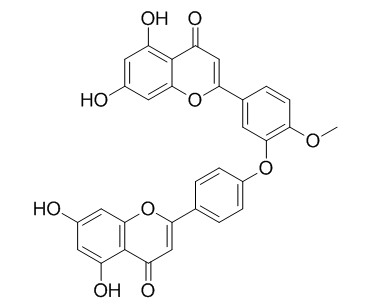4'-O-Methylochnaflavone
Reference standards.
Inquire / Order:
manager@chemfaces.com
Technical Inquiries:
service@chemfaces.com
Tel:
+86-27-84237783
Fax:
+86-27-84254680
Address:
1 Building, No. 83, CheCheng Rd., Wuhan Economic and Technological Development Zone, Wuhan, Hubei 430056, PRC
Providing storage is as stated on the product vial and the vial is kept tightly sealed, the product can be stored for up to
24 months(2-8C).
Wherever possible, you should prepare and use solutions on the same day. However, if you need to make up stock solutions in advance, we recommend that you store the solution as aliquots in tightly sealed vials at -20C. Generally, these will be useable for up to two weeks. Before use, and prior to opening the vial we recommend that you allow your product to equilibrate to room temperature for at least 1 hour.
Need more advice on solubility, usage and handling? Please email to: service@chemfaces.com
The packaging of the product may have turned upside down during transportation, resulting in the natural compounds adhering to the neck or cap of the vial. take the vial out of its packaging and gently shake to let the compounds fall to the bottom of the vial. for liquid products, centrifuge at 200-500 RPM to gather the liquid at the bottom of the vial. try to avoid loss or contamination during handling.
Tumour Biol.2015, 36(9):7027-34
Separations2023, 10(4),255.
J Korean Soc Food Sci Nutr2023, 52(7): 750-757
Turkish Journal of Pharmaceutical Sciences2022, DOI: 10.4274
J Chromatogr B Analyt Technol Biomed Life Sci.2018, 1080:27-36
Nutrients.2024, 16(22):3805.
Kaohsiung J Med Sci.2023, 10.1002/kjm2.12764
Industrial Crops and Products2022, 188:115596.
Plants (Basel).2020, 9(11):1555.
Ind Crops Prod.2015, 67:185-191
Related and Featured Products
Life Sci. 1995;57(6):551-8.
Suppression of mouse lymphocyte proliferation in vitro by naturally-occurring biflavonoids.[Pubmed:
7623623]
In a continuing effort to investigate biological activities of flavonoids, nine biflavonoids, isolated from three plant sources were evaluated for their suppressive effects on mouse lymphocyte proliferation.
METHODS AND RESULTS:
The biflavonoids tested were amentoflavone, bilobetin, ginkgetin, isoginkgetin, sciadopitysin, ochnaflavone, 4'-O-Methylochnaflavone, cryptomerin B and isocryptomerin. At 10 uM, several biflavonoids such as ginkgetin, isoginkgetin, ochnaflavone, cryptomerin B and isocryptomerin showed the suppressive activity against lymphocyte proliferation induced by Con A or LPS. Apigenin (flavone) and quercetin (flavonol) were suppressive against Con A-induced lymphocyte proliferation, but not against LPS-induced lymphocyte proliferation at the same concentration range. Biflavonoids were found to be irreversible inhibitors of lymphocyte proliferation.
CONCLUSIONS:
This is the first report describing the suppressive effects of naturally-occurring biflavonoids against lymphocyte proliferation.



